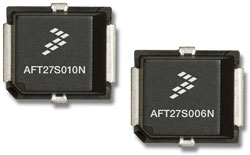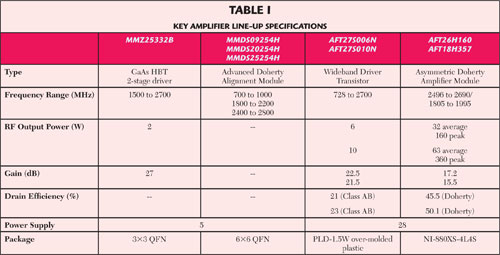
RF power amplifier designers often face the prospect of creating and optimizing a circuit for one set of frequencies and RF power levels; then attempting to revise it to cover other combinations of frequency and power. The best strategy to achieve this goal is to use the smallest number of different transistors to minimize redesign and overall cost. To accommodate this increasingly common requirement, Freescale® Semiconductor Inc. has introduced predriver, driver and asymmetric Doherty final-stage power transistors within its AirfastTM family that make this easier to achieve in TD-LTE and FDD-LTE cellular base stations. To complement the Airfast devices, the company has also introduced the industry’s first module that can significantly reduce the time and effort required to align asymmetric Doherty amplifiers in production.
Two lineups, one at 1.8 GHz and one at 2.6 GHz, with similar circuit architectures illustrate how these devices can be employed in real-world applications. The circuits each include a predriver driver, and final-stage amplifier, along with the Advanced Doherty Alignment Module (ADAM).
The lineups for both frequency ranges are shown in Figure 1. The first lineup is designed for use in a 2×40 W or 4×40 W MIMO base station in the 1.8 GHz band, the most popular FDD-LTE band in the world. The second lineup is applicable for the second most popular band, 2.6 GHz. This band is especially popular in North America and China where 8×20 W MIMO solutions are often employed. In the 1.8 GHz lineup, the MMZ25332B predriver is followed by the MMDS20254H ADAM module, two AFT27S010N drivers and the AFT18H357 final-stage amplifier. The 2.6 GHz lineup employs the same predriver, the MMDS25254H ADAM model, two AFT27S006N 6 W drivers and a 160 W AFT26H160 final-stage amplifier.

Figure 1 Device lineups for a 40 W amplifier operating at 1.8 GHz and a 20 W amplifier operating at 2.6 GHz. Both lineups use the same predriver and vary in the ADAM module, driver and final-stage amplifier dictated by operating frequency and RF output power.
The predriver in all cases is the MMZ25332B GaAs MMIC, which is in the company’s family of 5 V DC drivers and pre-drivers that includes 1, 2 and 3-stage amplifiers with RF output levels ranging from 250 mW to 4 W that are housed in compact over-molded plastic packages. The performance of the MMZ25332B can be optimized for any frequency between 1500 and 2700 MHz and is well suited for multi-band power amplifiers, as a driver for DPD-corrected Doherty power amplifiers, and as a final-stage amplifier in uncorrected small cell base stations.
The drivers include the 6 W AFT27S006N and 10 W AFT27S010N that are housed in PLD-1.5W over-molded plastic packages. The AFT27S006N delivers 22 to 24.3 dB gain with 0.05 dB gain flatness and 18 to 22 percent efficiency. The AFT27S010N has 21 to 24.3 dB gain with 0.2 dB gain flatness, and 21 to 25 percent efficiency. Both drivers cover the full cellular infrastructure frequency range of 700 to 2700 MHz.
The two final-stage amplifiers used in this illustration are the AFT26H160-4S4 160 W, 1.6:1 asymmetric Doherty device that provides 15.5 dB of gain and greater than 45.5 percent drain efficiency at 32 W of average output power between 2496 and 2690 MHz. The AFT18H357-24S is also a 1.6:1 asymmetric in-package Doherty device that delivers 360 W of peak RF power between 1805 and 1995 MHz with average power of 63 W, 50 percent efficiency, and 17.2 dB of gain. Table 1 summarizes the key amplifier specifications.

The ADAM module placed between the predriver and driver stages can provide unique benefits for manufacturers. Designed specifically with Freescale’s in-package asymmetric Doherty power amplifiers in mind, it can ensure consistent performance throughout an amplifier manufacturer’s production line, while improving yield and providing tighter parametric distributions that increase system efficiency. It can also be adjusted in the field to optimize the amplifier for traffic loading, changes in frequency, operating temperature, or any other environmental condition.
The three current ADAM models include the MMDS09254H, MMDS20254H and MMDS25254H that collectively cover frequencies between 700 and 2700 MHz. They operate from a single 5 V DC supply, draw about 12 mA, and accept commands via a TTL/CMOS/SPI digital interface designed for 1.8 or 3.3 V DC logic. The devices are housed in 6×6 mm QFN surface mount plastic packages.
An ADAM module can optimize Doherty bandwidth, improve DPD correction and full-band efficiency, and enable consistent asymmetric Doherty performance of any
Freeescale in-package Doherty amplifier. The devices incorporate a 90-degree directional coupler, digitally-selectable phased shifters, as well as programmable attenuators. All devices used in the reference lineups are in production and frequency-specific reference designs are available.
The lineup approach demonstrated by these examples allows RF power amplifier designers to save considerable design time and reduce their bill of materials by using a single predriver, the same architecture for each circuit and similar devices for ADAM, driver and finals based on frequency and power requirements.
Freescale Semiconductor Inc.,
Tempe, AZ,
www.freescale.com/rf
